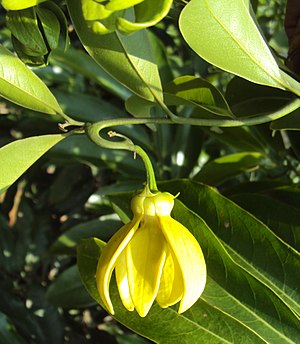Note: This is a project under development. The articles on this wiki are just being initiated and broadly incomplete. You can Help creating new pages.
Difference between revisions of "Artabotrys hexapetalus - Harachampaka"
(→Fruit) |
|||
| Line 41: | Line 41: | ||
===Fruit=== | ===Fruit=== | ||
| − | {{Fruit|Etaerio of follicles||Fruitlets 14-20, ovoid, apiculate, 3-4 cm long, glabrous; seeds brown | + | {{Fruit|Etaerio of follicles||Fruitlets 14-20, ovoid, apiculate, 3-4 cm long, glabrous; seeds brown}} |
| + | |||
===Other features=== | ===Other features=== | ||
Revision as of 16:28, 16 April 2019
Contents
- 1 Uses
- 2 Parts Used
- 3 Chemical Composition
- 4 Common names
- 5 Properties
- 6 Habit
- 7 Identification
- 8 List of Ayurvedic medicine in which the herb is used
- 9 Where to get the saplings
- 10 Mode of Propagation
- 11 How to plant/cultivate
- 12 Commonly seen growing in areas
- 13 Photo Gallery
- 14 References
- 15 External Links
Uses
[[:Category:Ayurvedic Herbs known to be helpful to treat |]], [[:Category:Ayurvedic Herbs known to be helpful to treat |]], [[:Category:Ayurvedic Herbs known to be helpful to treat |]], [[:Category:Ayurvedic Herbs known to be helpful to treat |]], [[:Category:Ayurvedic Herbs known to be helpful to treat |]], [[:Category:Ayurvedic Herbs known to be helpful to treat |]], [[:Category:Ayurvedic Herbs known to be helpful to treat |]], [[:Category:Ayurvedic Herbs known to be helpful to treat |]], [[:Category:Ayurvedic Herbs known to be helpful to treat |]], [[:Category:Ayurvedic Herbs known to be helpful to treat |]], [[:Category:Ayurvedic Herbs known to be helpful to treat |]].
Parts Used
Chemical Composition
Common names
| Language | Common name |
|---|---|
| Kannada | kandaala sampige, madana kaamaeshvari, manoranjana |
| Hindi | harichampa, madanmast |
| Malayalam | madanakameswari, manoranjitam |
| Tamil | manoranjitham |
| Telugu | manoranjithamu, muddasampenga, phalasampanga, manoranjidamu |
| Marathi | hiravaachaapa, hirvachampa |
| Gujarathi | |
| Punjabi | |
| Kashmiri | |
| Sanskrit | harachampaka, madanah, nilachampaka |
| English |
Properties
Reference: Dravya - Substance, Rasa - Taste, Guna - Qualities, Veerya - Potency, Vipaka - Post-digesion effect, Karma - Pharmacological activity, Prabhava - Therepeutics.
Dravya
Rasa
Guna
Veerya
Vipaka
Karma
Prabhava
Habit
Identification
Leaf
| Kind | Shape | Feature |
|---|---|---|
| Simple | alternate | elliptic-oblong, acute at base, shortly acuminate at apex, 6-15 x 2- 4.5 cm, glabrous; lateral nerves 6-18 pairs. |
Flower
| Type | Size | Color and composition | Stamen | More information |
|---|---|---|---|---|
| Bisexual | solitary | Yellow | Many | Flowers solitary or paired on terminal or leaf opposed hooked peduncles, ca 2 cm across, fragrant; pedicels ca 1 cm long, pubescent. Sepals ovate, recurved, 5-7.5 x 5-6 cm, pubescent. Petals lanceolate, saccate or concave at base; outer ones 2-3 x 0.5-0.7 cm; the inner slightly smaller, appressed-villous. Stamens many, anthers beaked concealing the anther cells. Carpels many, oblong, pubescent or glabrous; ovules 2; stigma clavate |
Fruit
| Type | Size | Mass | Appearance | Seeds | More information |
|---|---|---|---|---|---|
| Etaerio of follicles | Fruitlets 14-20, ovoid, apiculate, 3-4 cm long, glabrous; seeds brown | {{{4}}} | {{{5}}} | {{{6}}} |
Other features
List of Ayurvedic medicine in which the herb is used
Where to get the saplings
Mode of Propagation
How to plant/cultivate
Commonly seen growing in areas
Tropical area, Sub Tropical area, Gardens
Photo Gallery
References
External Links
- Pages that are stubs
- Ayurvedic Herbs known to be helpful to treat
- Herbs with common name in Kannada
- Herbs with common name in Hindi
- Herbs with common name in Malayalam
- Herbs with common name in Tamil
- Herbs with common name in Telugu
- Herbs with common name in Marathi
- Herbs with common name in Sanskrit
- Habit - Straggling shrub
- Index of Plants which can be propagated by Cuttings
- Herbs that are commonly seen in the region of Tropical area
- Herbs that are commonly seen in the region of Sub Tropical area
- Herbs that are commonly seen in the region of Gardens
- Herbs
- Climber




